This was a match played on an extremely high level and probably one of the best games of the entire 2019/20 campaign. At the Etihad Stadium, two teams fought for a place in the UEFA Champions League quarter-final as the clash ended up in a 2-1 victory for Manchester City (4-2 on aggregate).
It is hard to use words and our dogmatic tactical terms to dissect this game as the tactics of Pep Guardiola were quite extraordinary. By contrast, Real Madrid were unable to solve some deep-rooted issues that haunted them throughout this campaign, hence, they lost the game.
Lineups
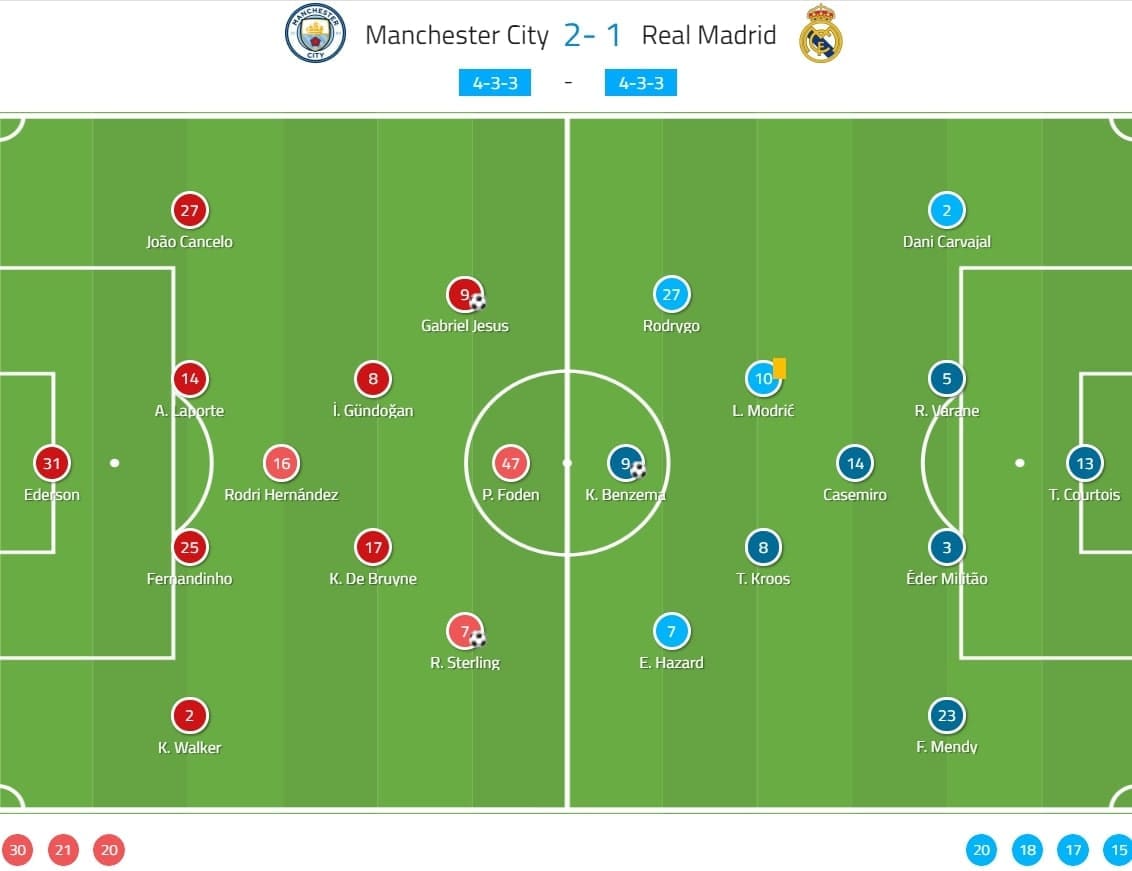
Manchester City sent out their best team on the pitch with Fernandinho starting as Aymeric Laporte’s partner. Meanwhile, Phil Foden played at the centre and, maybe surprisingly, took Riyad Mahrez’s position as well. It was a 4-3-3 formation, but only on paper.
Zinédine Zidane played his team in a 4-3-3 formation as well. This was a very aggressive team as the midfield was formed by Toni Kroos, Casemiro and Luka Modrić, without Federico Valverde. Eden Hazard returned to the squad with Rodrygo starting on the right flank. Raphaël Varane and Éder Militão partnered up for the centre-back positions with Sergio Ramos unavailable.
Madrid’s efforts were in vain
Although keeping an excellent defensive record in La Liga, as I have explained in my previous analysis, the defence of Real Madrid is far from perfect. Apart from the individual errors, they just could not stop City from creating chances.
In the press, Madrid tended to defend in a man-orientated manner but this time, Kroos was the player to form the first line with Karim Benzema. This was reasonable as we concluded Modrić was unable to cope with the quick tempo during this phase. However, this was very difficult as Madrid did not have a plan to nullify the impact of Ederson.
Apart from City playing suboptimal passes in the build-up, Madrid were unable to force errors and regain possession near the final third. In the first 15 minutes, more often Casemiro approached Rodrigo Hernández (not in this image).
In this example, they allowed Ederson to play the long balls despite the backline being isolated against the likes of Gabriel Jesus and Raheem Sterling. This would be fine as long as the aerial ability of the Madrid defenders was far better than the short attacking players of City.
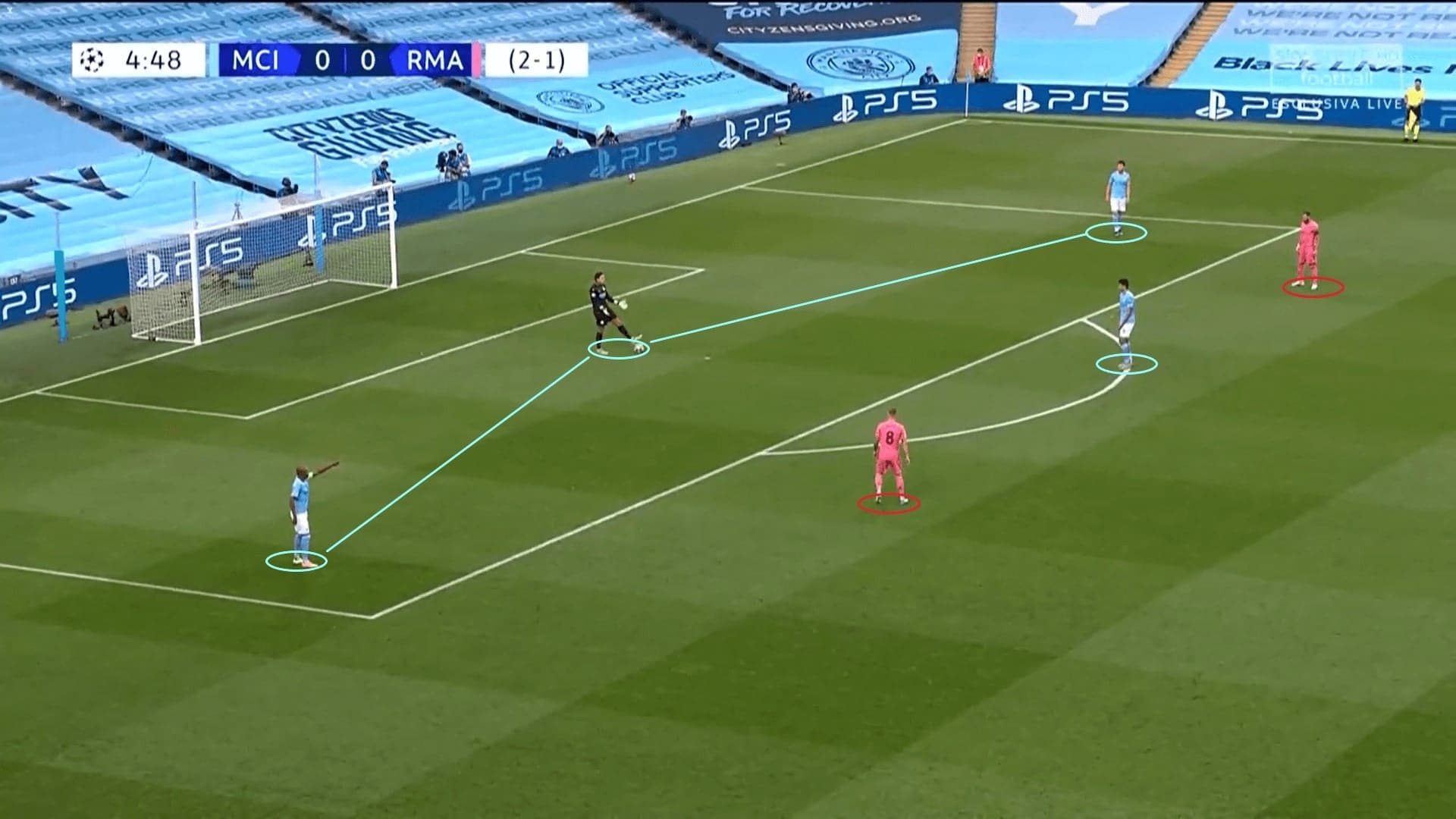
However, things went terribly wrong, especially after Sterling scored an opener for the home side. To increase the possibility to regain possession, Madrid simply pushed Modrić into an advanced position, which could be interpreted as a 4-3-3 shape. The most important was that this defensive structure was hugely imbalanced and gaps were everywhere horizontally.
When Modrić pushed up, he failed to cope with the movement of İlkay Gündoğan, who was a clever player that always stayed behind the first line. Without collective efforts, clear principles and strategies during the press, Madrid failed to pressure the first line of City while leaving huge spaces at the central third.
Usually, Rodrygo or Casemiro should have provided the defensive cover for Modrić, but it was not happening because of their man-marking approach. Rodrygo was dragged wide by João Cancelo, and Casemiro is largely overloaded by Foden whenever trying to cover the midfield.
Given the horizontal gaps between players and lax pressuring activity at the front, it was too easy for City to play the out-balls. Here, Rodri simply picked Gündoğan with a pass that broke the midfield of Madrid.
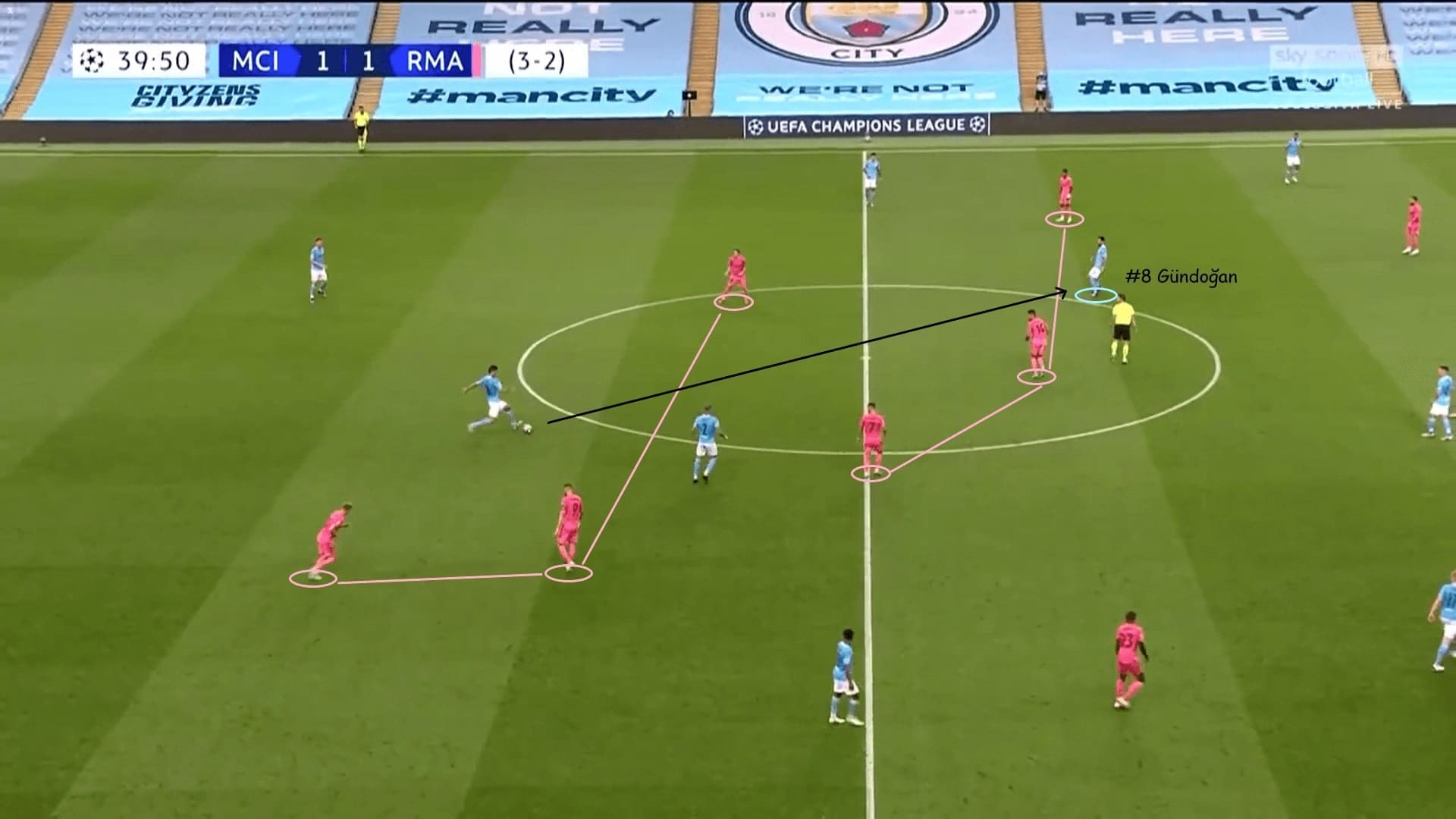
Another example here and we have to mention that keeping Valverde on the bench was conducive to the attack. But it also came for a price as the players on the pitch were not good at defending. Except for Modrić and Kroos, another player was Hazard. Undoubtedly, he offered the offensive threat, but it was a great mismatch whenever seeing the Belgian international trying to cover the free players, such as Kyle Walker below.
Of course, it was a two-sided coin with Hazard. On some occasions, he distanced himself from his teammates during defence, operating as a “gambling winger” and this could trigger some counter-attacks, but it was not enough to score goals.
In the second half, things were worse as Madrid were not even pressing. Their inability to regain the ball, plus, spending too much energy in the first half has led to this passive approach. A low block was formed, and all men were behind the ball as they just could not get out of the structure of City to trigger the transitions. The only pressure, without any coordination, has led to Jesus’ goal.
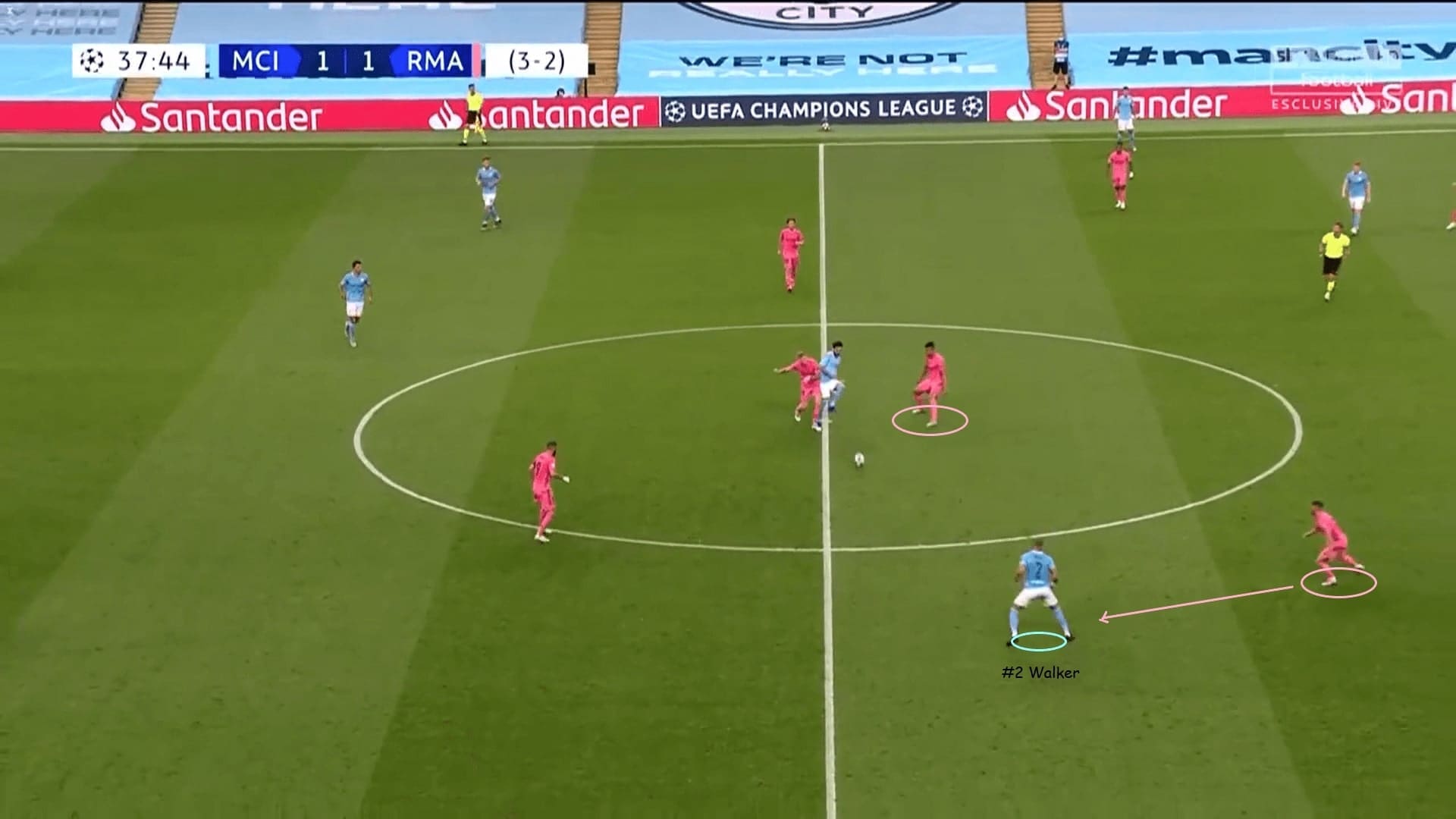
City exploiting the flaws
As the best build-up team in the world, City did show very promising ability to evade the Madrid press and create their chances from positional plays. We mentioned how City successfully circulated the ball through a three-man backline (or four, including Ederson), and the key to success was to find the free player.
Below is an instance where Fernandinho was able to play the out-ball because Rodri and Laporte absorbed the pressure. The mismatch and leeway were always on the right side because Hazard had an awkward duty to perform. Kroos was the left midfielder, whenever he went high, someone had to provide the defensive cover and this was inevitably Hazard.
When De Bruyne appeared on this side and further drew Hazard narrow, Walker often served as the free player to progress play, including this example. Note that Ferland Mendy was not available to jump out since the winger occupied him. It was very easy for City to get behind the Madrid midfield.
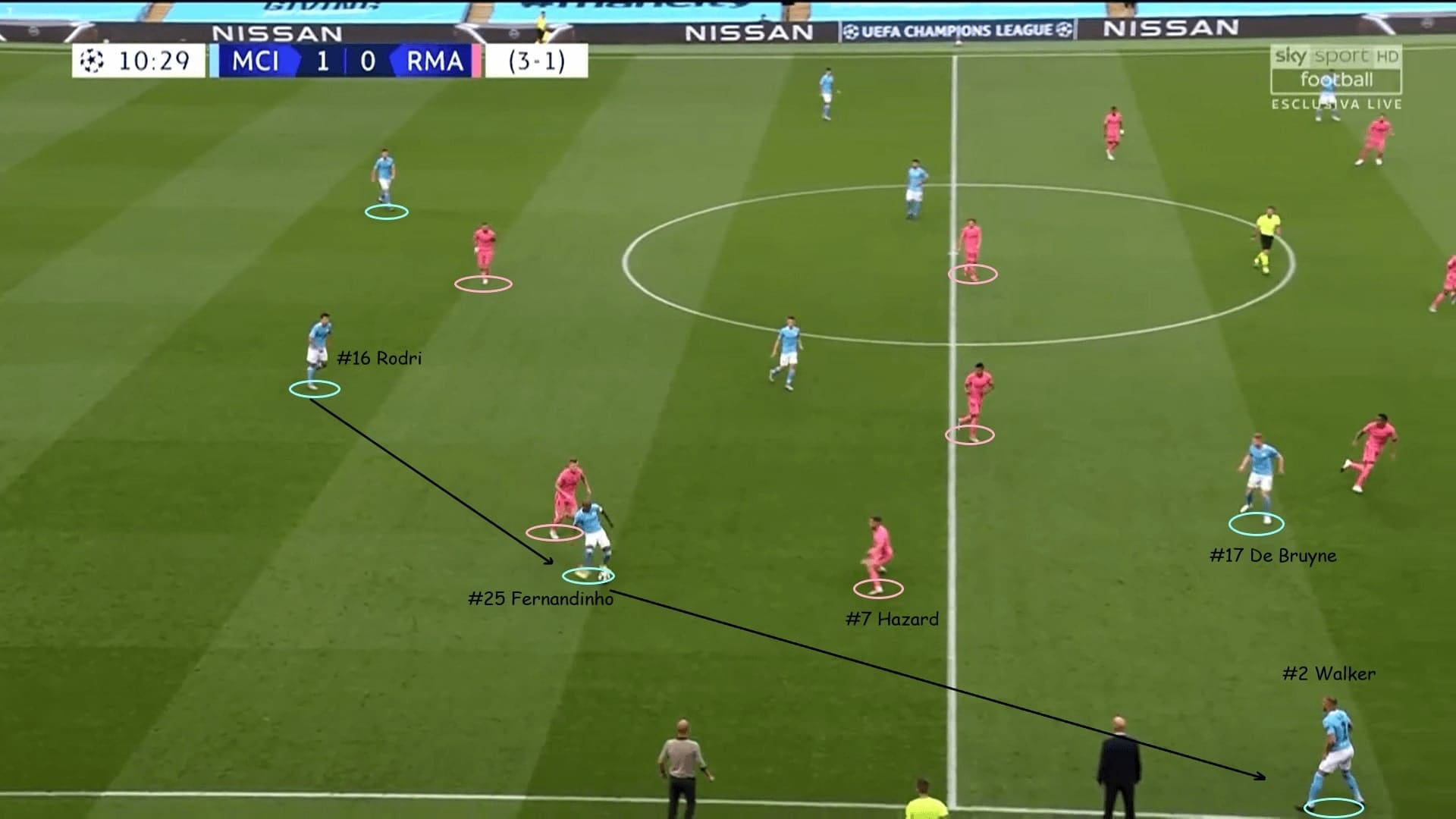
A very key player was Gündoğan, who handed a top-class performance which is seldom recognised by the supporters. The duty of the German international was to lurk behind Modrić and be available to provide the second layer or drag Casemiro with him. Foden or De Bruyne would drop to overload the Brazilian, which was a strategy to help City find a free man to create the chances behind the Madrid press.
One of Pep’s changes included the role of Walker and the wingers. In the first half-an-hour, the narrow wingers were not effective to create the chances in the final third (body shapes and the positions to receive the ball). Although playing a pair of wide full-backs was a good choice, Guardiola tweaked the tactics a bit by reversing the role of these players.
Now, Walker went to the half-spaces while the winger occupied the wide zone. This is demonstrated in this image below. The key ideas did not change, still, exploiting the loose pressing of the opponents, and the interconnectedness of players was stronger after this change.
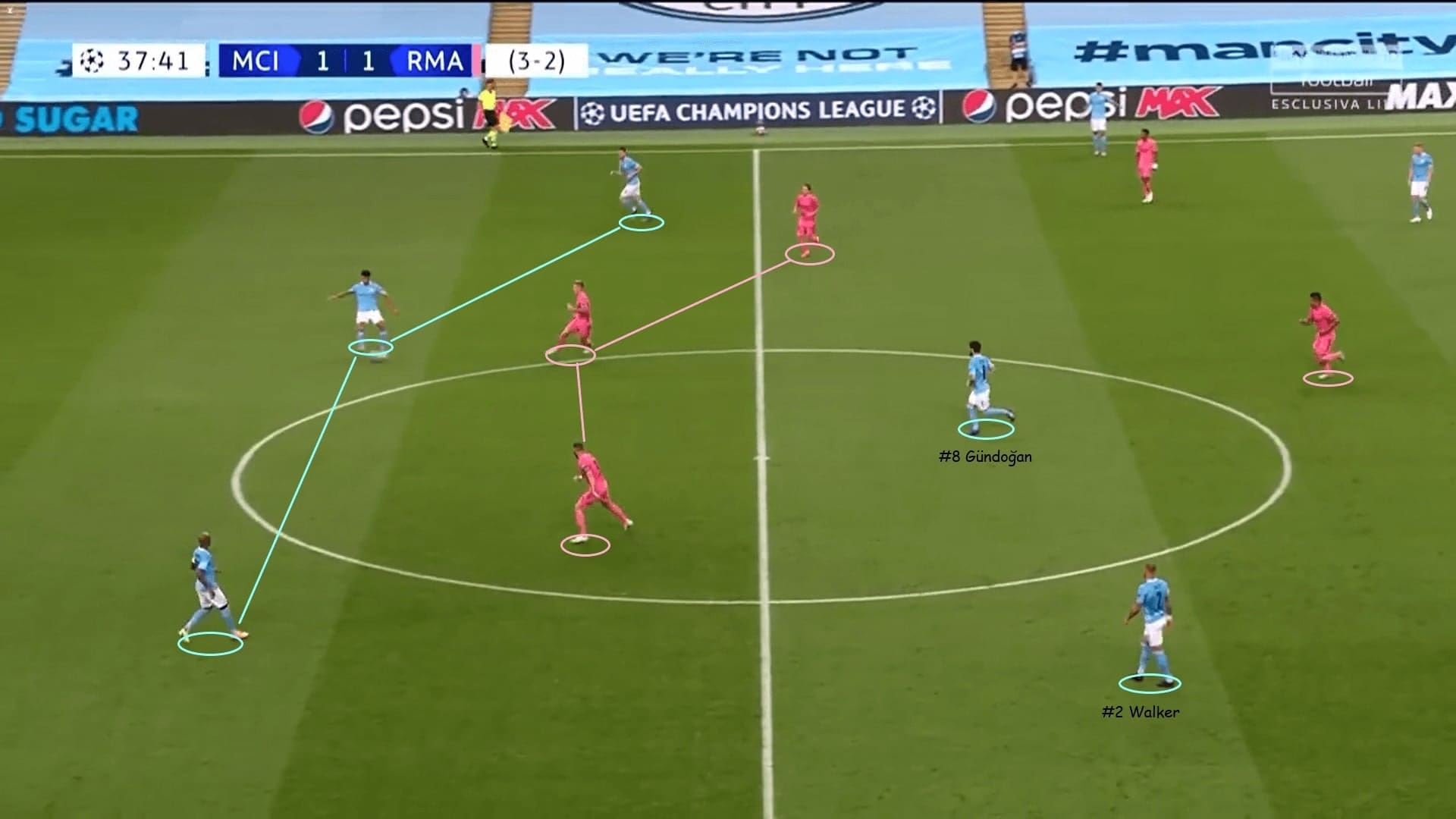
Therefore, City were more capable of exploiting the defensive flaws of Madrid in the second half. Huge damage should’ve been done earlier when Madrid were not pressing, and when Modrić and Kroos were not defending.
Casemiro had a very difficult job in terms of defending as he did not want the centre-back being isolated in the 1 v 1 situations. When City played the ball to the highest player, the Brazilian was inevitably focused on the ball, leaving spaces for De Bruyne to exploit.
City mastered some offensive plays such as the third man combination and this certainly helped to release De Bruyne as a free player in the final third, such as this scene in the second half. I have to give another compliment to Gündoğan again, he is really clever and knows when to support and control the rhythm brilliantly. Below, we can see him connect City’s attack in the penalty area.
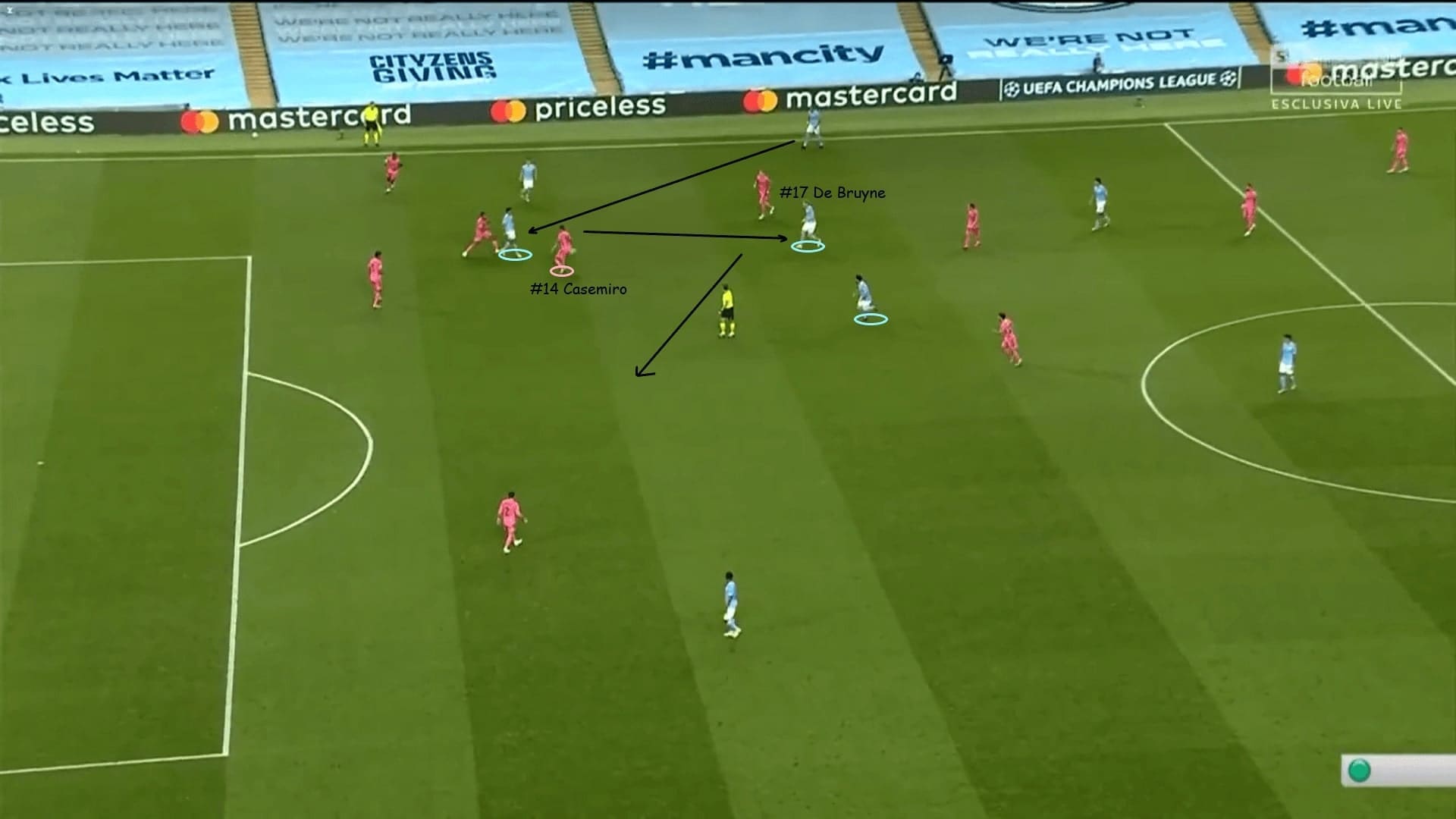
Masterclass in defensive setups
This is the most fascinating part of the game and this tactical analysis. City were simply brilliant to deny Madrid the chances to attack, and it was not easy to come up with a plan like this. The likes of Kroos and Modrić tended to drop very deep while a large scale of positional interchanges occurred. For example, the position of Benzema was irregular while Mendy and Carvajal could join the midfield.
Thinking and defending simply by a dogmatic approach such as “man-marking”, “zonal defending” were not the optimal solutions. Instead, Pep designed a pressing trap with the strategic press and also had troops that committed themselves fully to defend against Madrid.
City were coming with a strong sense of coordination and the pressing triggers were not clearly one signal but rather a combination of the players’ intelligence and judgement, as well as collective movements. Poor receiving shapes, lateral passes and return passes are some triggers, but the lead (Foden or Jesus, or whoever staying at the highest point of the pitch) has to be alert. The only pressing moment was when the ball was accessible and while teammates pushed high to support and complete the shape.
An example can be seen below – City were not pressing and were waiting for Madrid to play the ball. Initially, the Madrid midfielders between the lines should be covered. Gündoğan was demonstrating the basics of Guardiola’s pressing system – curving his runs to cover the passing lanes.
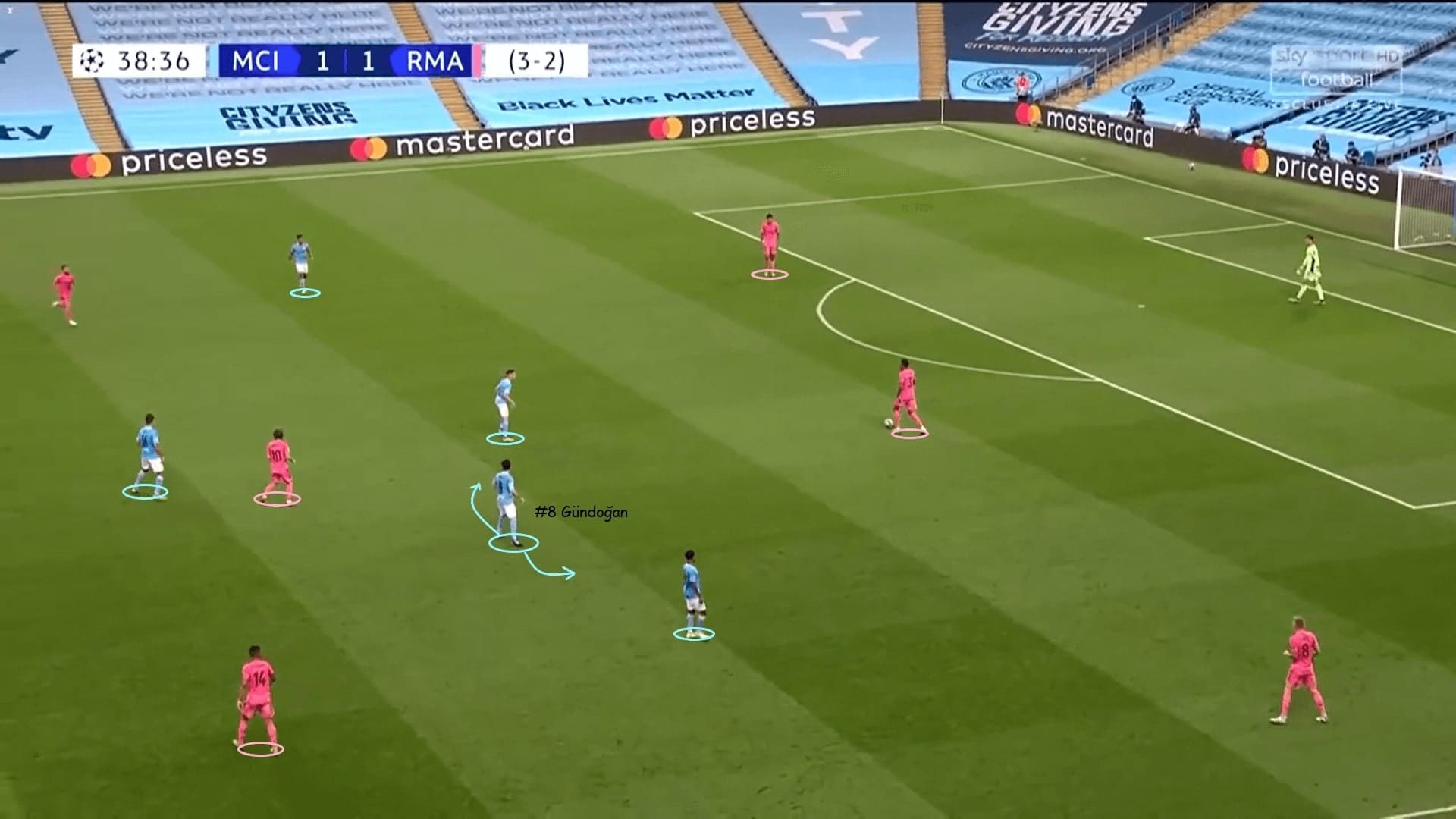
This is a pressing trap! Just three seconds later, Madrid discovered all targets were marked by City and they were not able to play out from the back. What happened in those seconds?
City were not standing but rather closed the Madrid midfielders in these minutes. Notice the difference between the above and below images. The pressing trap was set on one centre-back who was not marked and seemed to be an available target. When Foden pressed, the centre-backs exchanged the ball and the player to follow up must be quick, which was Gündoğan in this case.
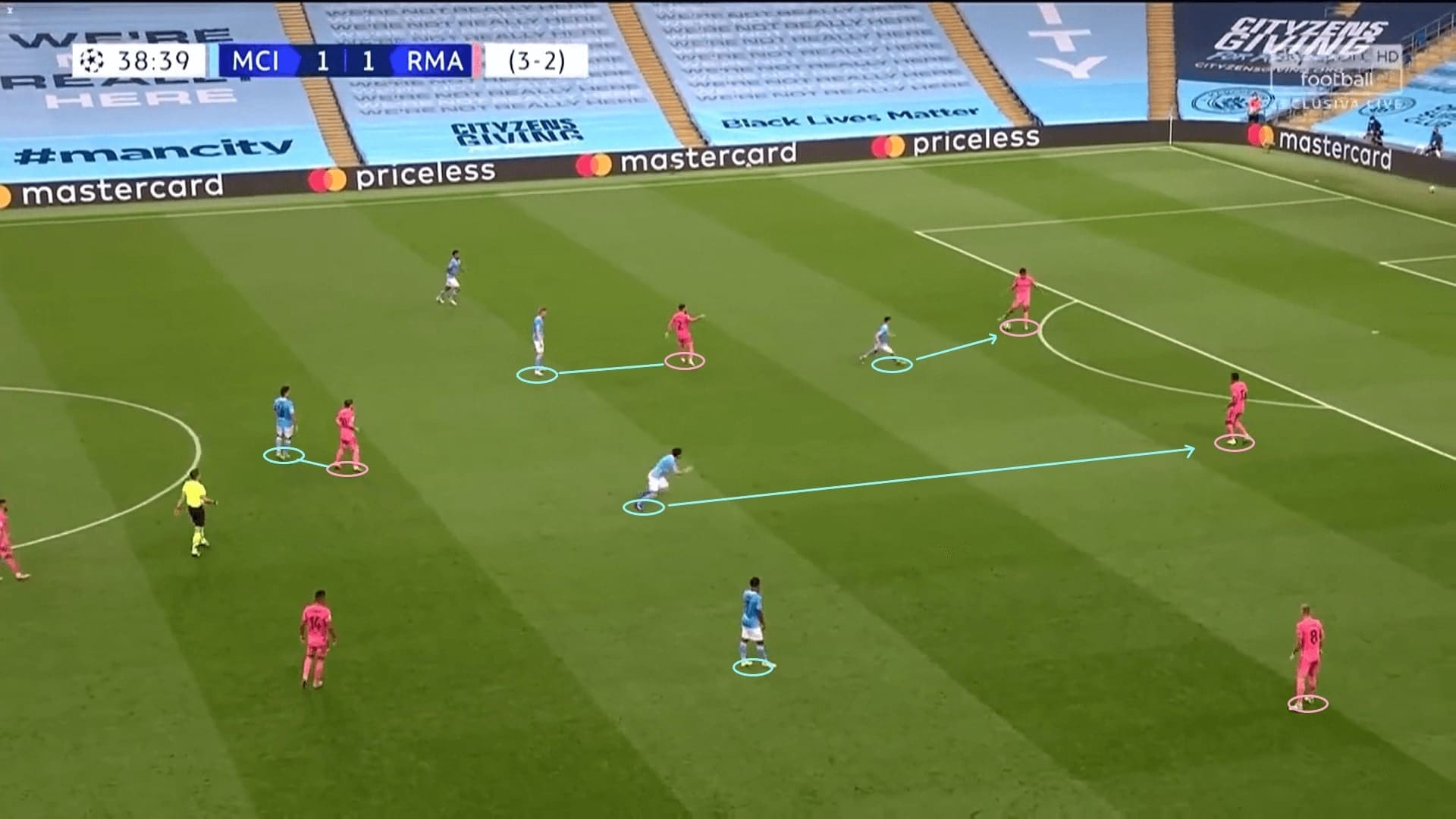
Below is another example illustrating another element in the press – communication. This was not necessarily a voiced-out message or a gesture. Scanning the pitch, perceiving information, judgement and execution were other forms of communication which City managed to get right.
Here, Foden scanned to ensure his teammates were here to support, while the rest of the team moved as a unit to shut the players on the opposite side. This was one of the pressing triggers – when the ball is played laterally between the centre-backs and the body orientation is sideways – press!
Intriguingly, Madrid were overloading from the pressing direction, but they never tried (or could not) to play the ball to that side.
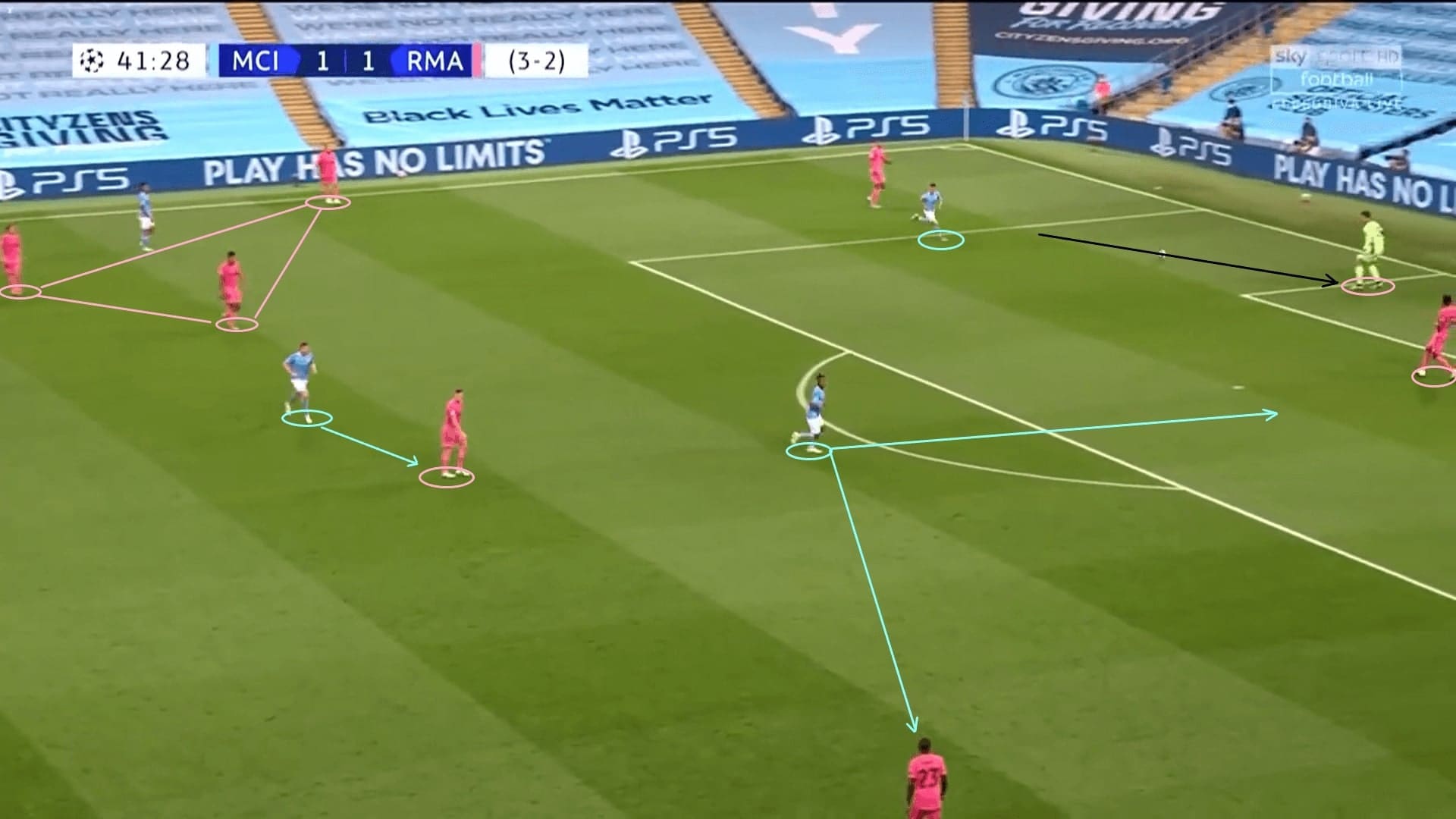
Some other defensive setups of Guardiola were brilliant as well. No shape, not a structure, but it was a fluid shield to protect the backline. The left-winger, Jesus, committed a lot to cover the wide zone. This was vital as hitting the underloaded side was Madrid’s strength so playing him here was a strategy to nullify the instant threat.
Meanwhile, another main theme was to cover Madrid’s midfielders, but only to those staying between the lines. Guardiola did not want the defence collapsed and chaotic during the pressure, as Madrid players, especially Kroos, were strong at recognising the passing lanes even under pressure. Therefore, the priority was to cover the players between the lines, even at the expense of letting a free midfielder to play the pass as Casemiro did below. But, given the central lanes were shut, long balls were played and the results were not good.
The high line (or medium-high) defence was setting the offside traps. It was fine given the likes of Hazard and Benzema did not possess pure pace, while Rodrygo was not used to run behind the backline. With Walker and Cancelo’s speed, Pep believed it was enough to deny Madrid from playing behind the backline.
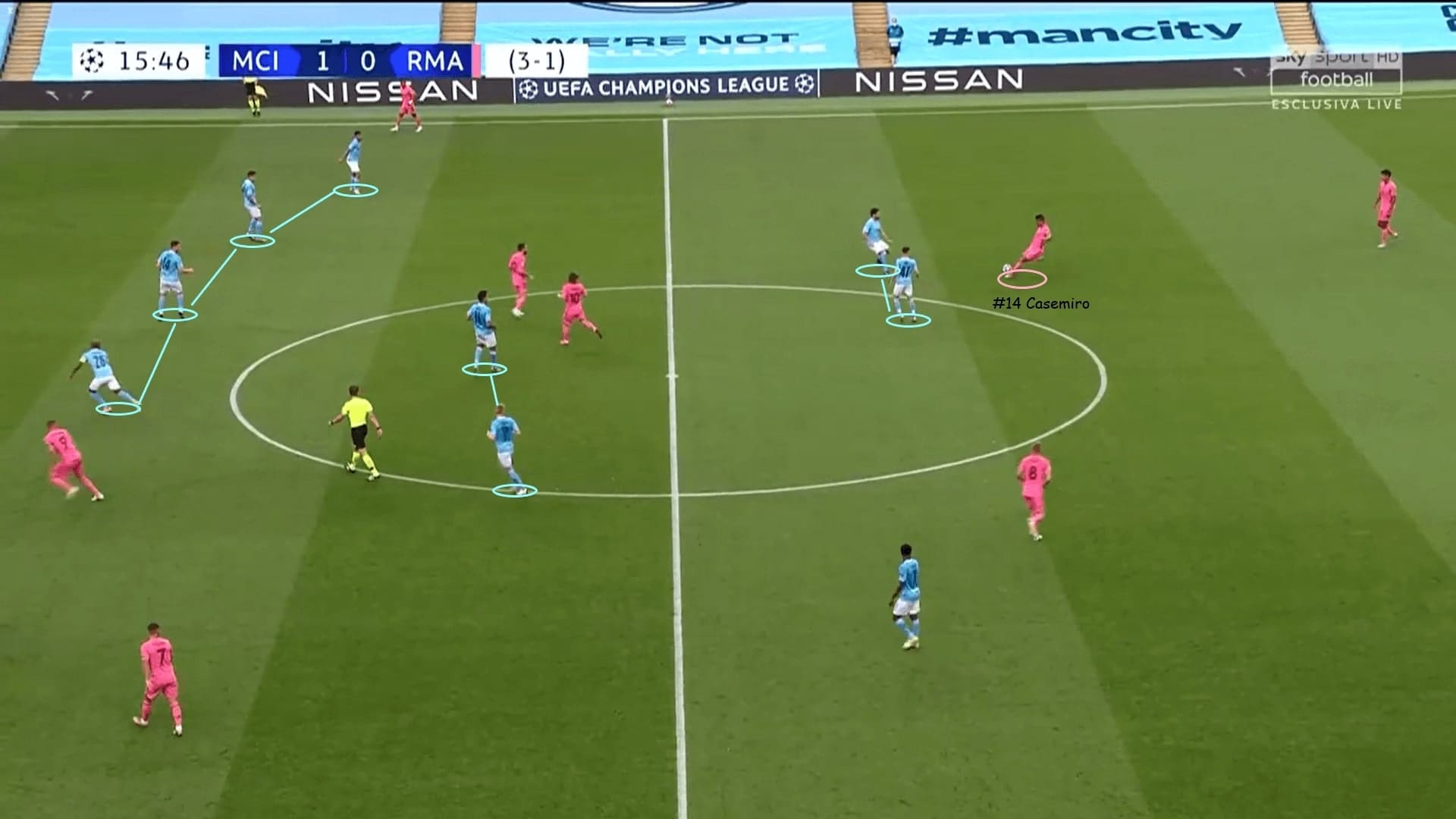
When defending lower on the pitch, City also had some objectives to accomplish and every player was committed to helping the team. Obviously, the threat and combinations on the flank and half-spaces, such as Hazard and Benzema on the left or Carvajal and Rodrygo on the right, are quick and difficult. The in-ball passing lanes had to be shut and City placed the midfielders to man-mark or shut those lanes.
An example here, De Bruyne on Hazard, or any player entering this region. Apart from the deep and low block, another thing that was impressive was the cross-field balls suffocated by City. The pressure was continuous in the defensive third of City, hence, direct switch of plays was not allowed here. If Madrid needed to circulate the ball through the backline, this definitely bought time for the disciplined trio of Gündoğan-Rodri-De Bruyne to shift and protect the opposite side.
If you remember Jesus’ role in the tactical preview, this was exactly what he was trying to do as a left-winger. When defending the underloaded side, he tried to intercept the ball or pressure the opponents as soon as possible. This was vital as things would be uncontrollable if the likes of Rodrygo and Carvajal were ready to combine at any time.
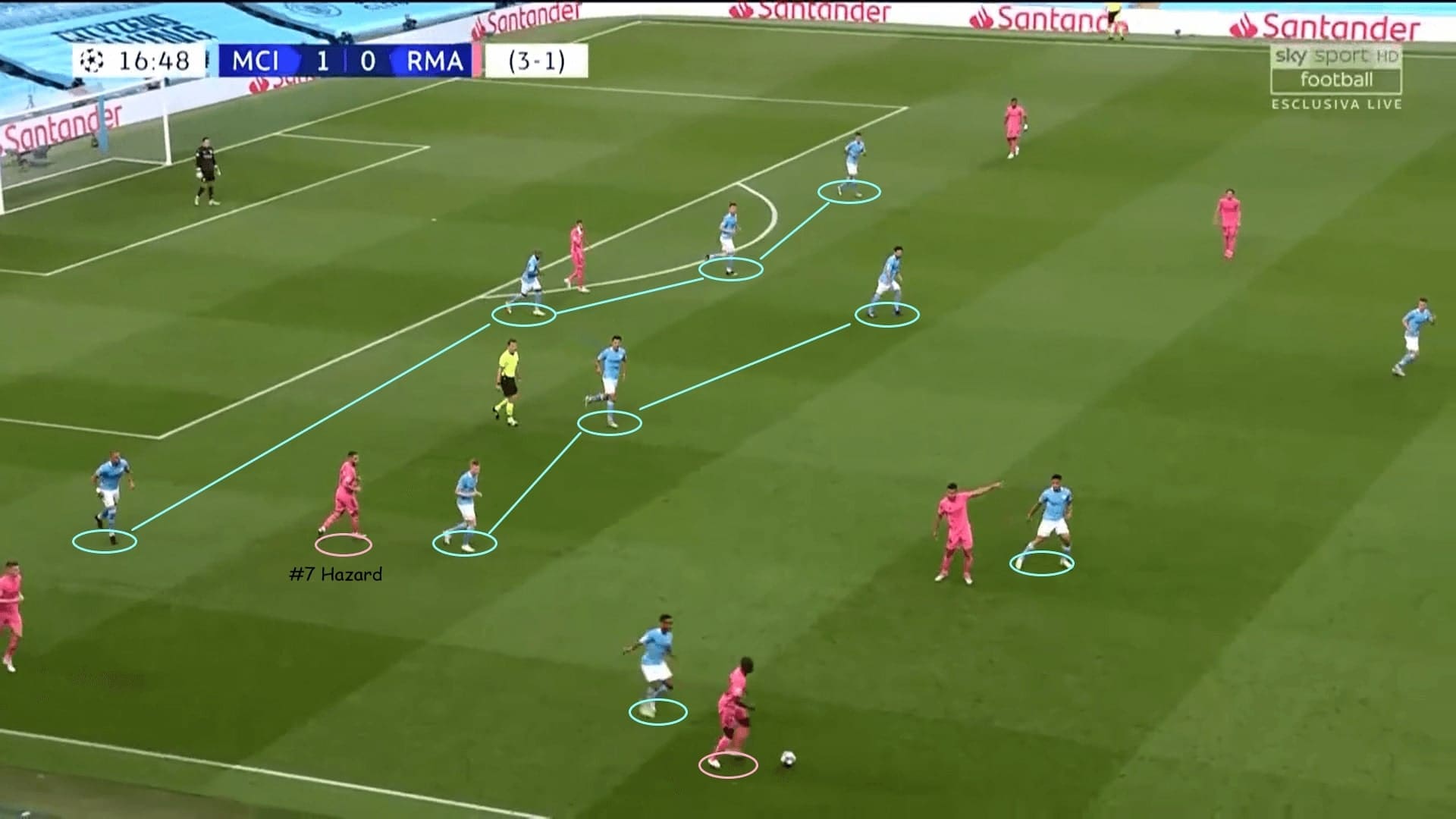
Speaking of that Sterling opener, many analyses would tell you it was attributed to City’s pressing or Varane’s error. In fact, it was about the same theme I mentioned, and it was a counter-pressing occasion.
When Madrid regained possession and Foden looked to counter-press, his discipline was impressive. The first action of the City #47 was to make a curved run to shield Casemiro and the central passing lane before accessing Varane. This was a vital move and it showed how Guardiola prepared for this game – covering the Madrid midfielders between the lines is always a priority.
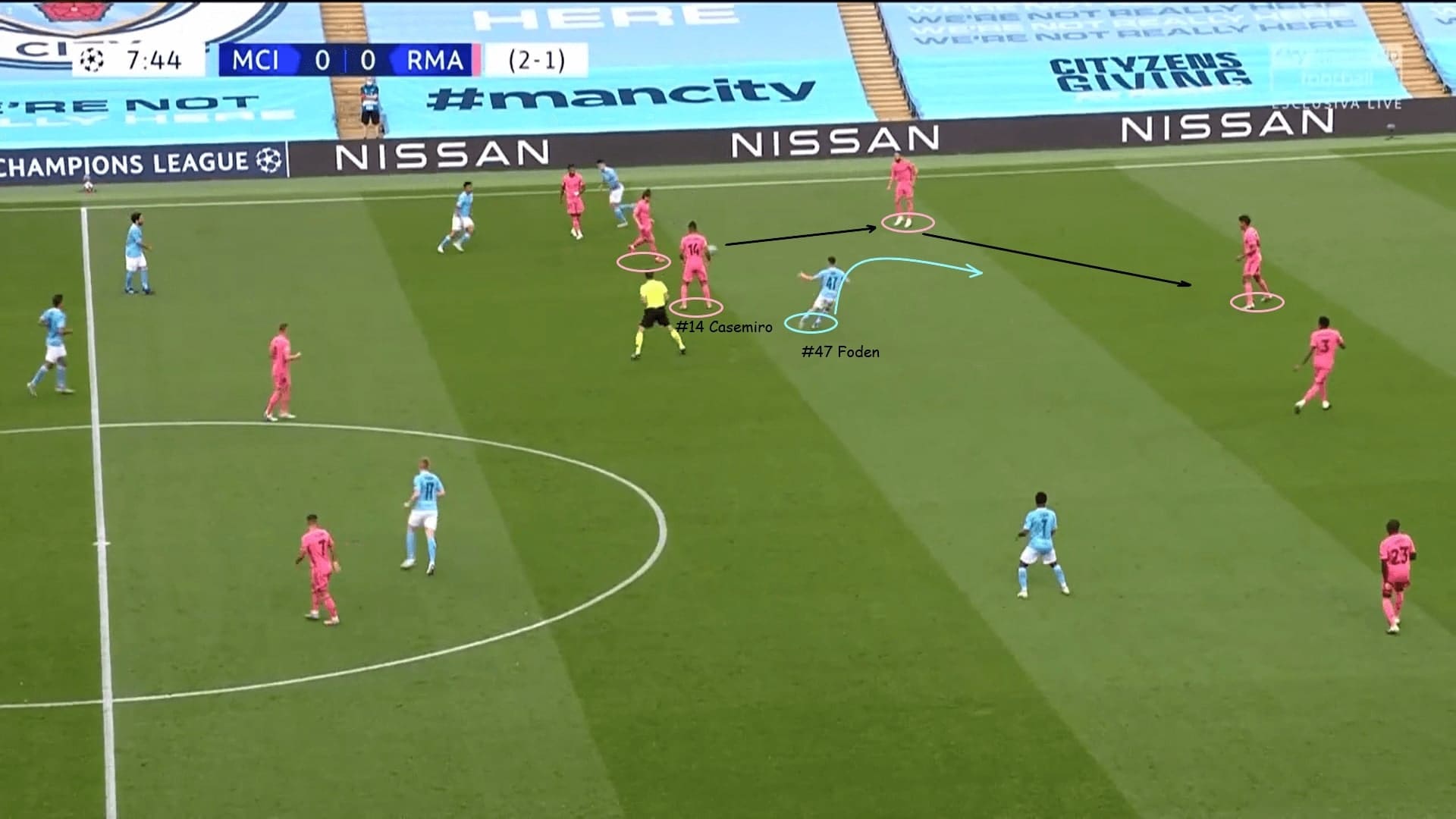
Difficulties to construct
Throughout the season, Madrid were not competent in terms of playing out from the back. In La Liga, Ramos or some individuals could step out to solve the issue by delivering excellent out-balls, but without the skipper on the pitch, things were difficult.
The only effective tool was to drop either midfielder in front of the centre-backs but City were happy to let them receive the ball or even turn and hold it. See how easy Modrić has bypassed Foden by carrying the ball forward below.
The personnel in midfield was the key, if it was Casemiro, who possessed limited offensive ability, then, it was almost impossible to make things happen. If it was either Modrić or Kroos, their long passes or line-breaking passes were a threat to City. However, numbers and quality between the lines were not good enough unless Hazard appears. If the Belgian international is not operating narrowly to open and trigger those passing lanes, the carrier could not find an option between the lines and they opted for a long ball – a strategy without clear benefits (or even intention).
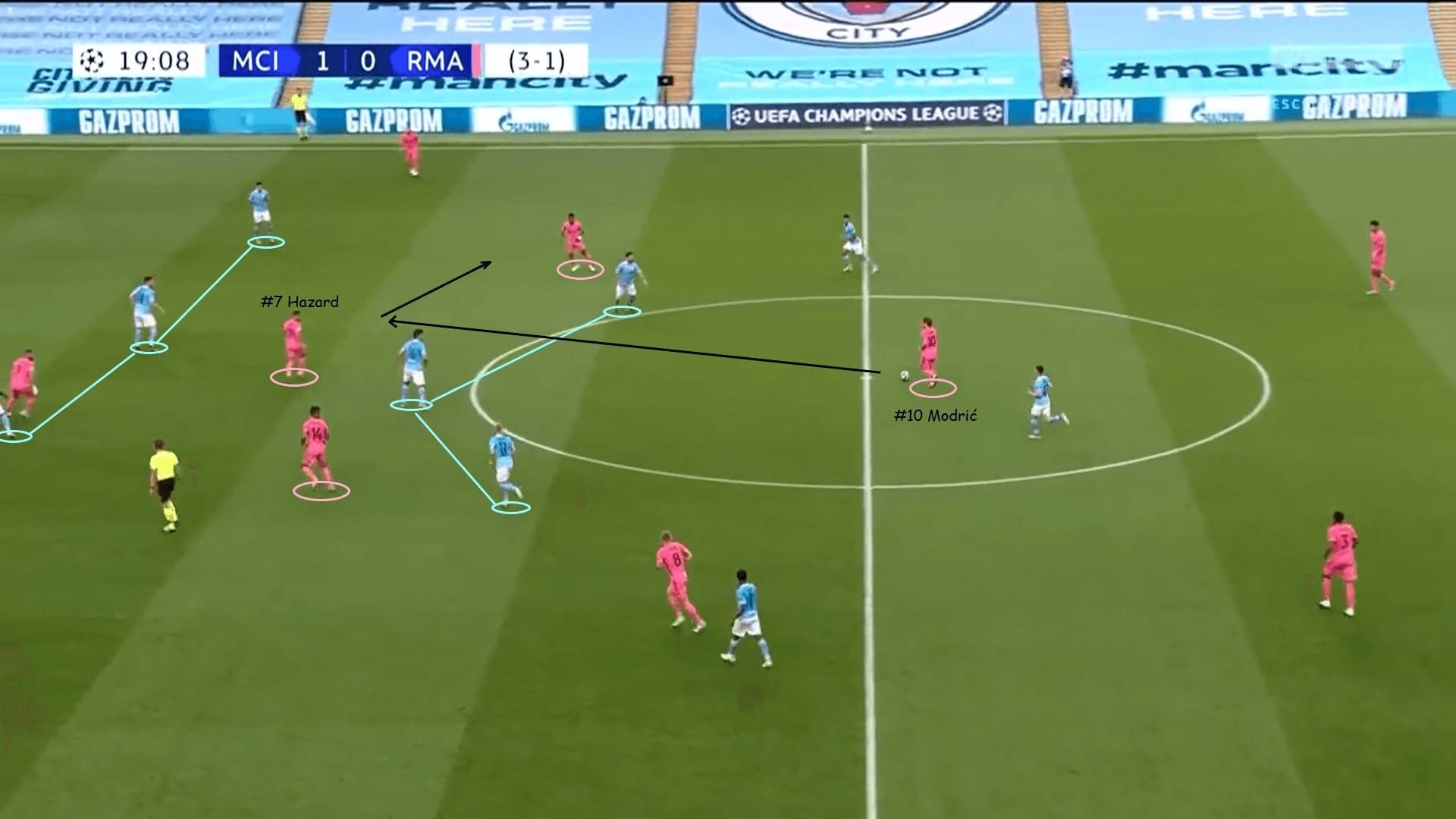
You could criticise Hazard’s performance on that night, but in fact, he was the only player to produce something in the offensive plays. One of the strongest links on the Madrid side came from Hazard and Kroos, which was another strategy to enter the final third – through Hazard’s dribbling. However, the Belgian left-winger would soon be surrounded by two to three players and it was difficult to progress.
Another commonly seen scenario was Kroos dropping to the left half-space. This released Mendy to an advanced position and the German international was free to play the out-balls. He was class, even under pressure or facing multiple players, and connecting another progressive option was just a simple task. The presence of Kroos was another huge reason why Pep did not want his team to press too aggressively.
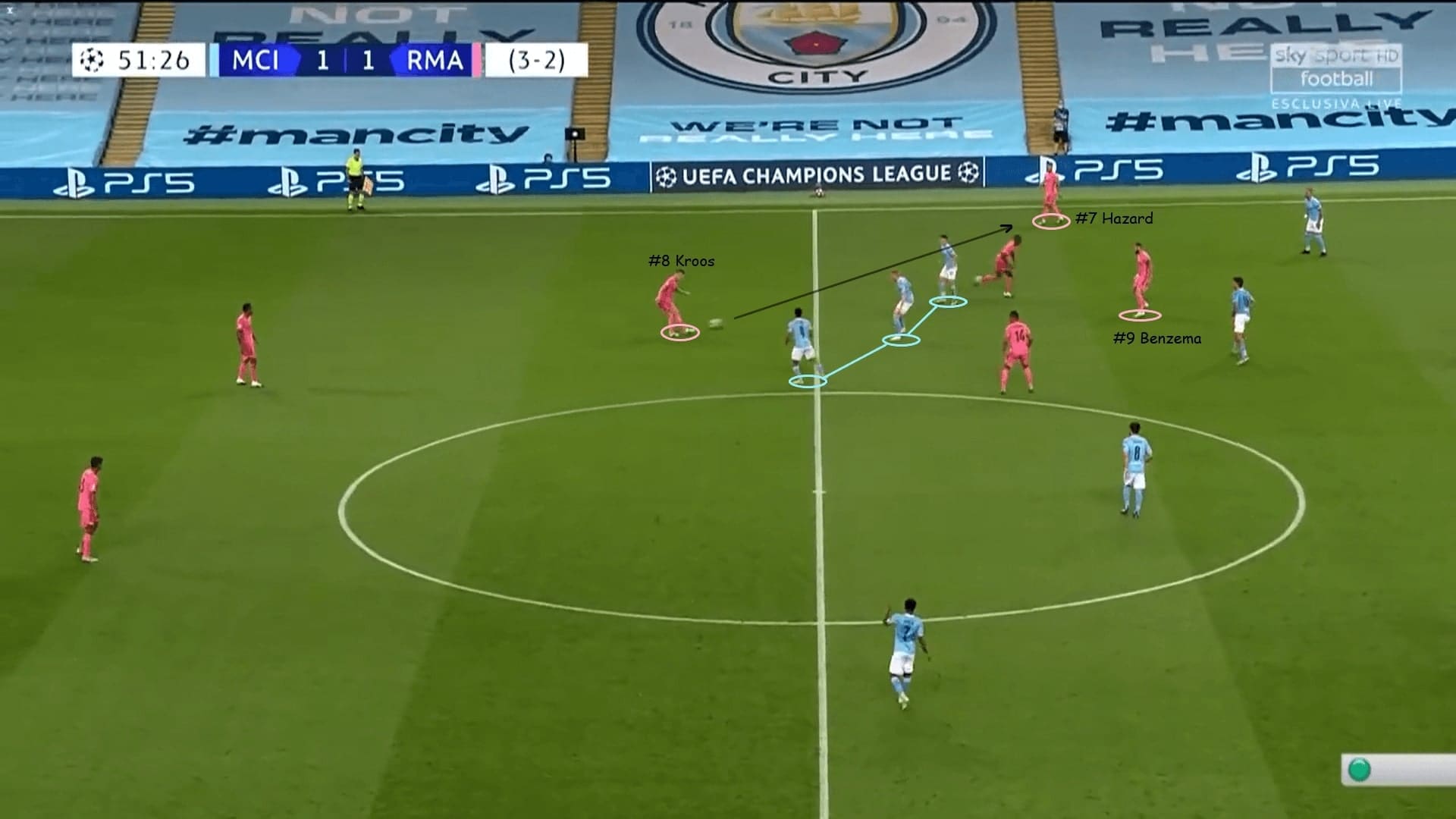
Our last game example shows the inefficacy of Madrid’s build-up plays. Without the above tools to develop an attack, they simply could not create anything. Even in a 4 v 3 situation below, Madrid could not beat the man-marking and find the free player. Instead, Varane opted for a long ball and the chance was gone.
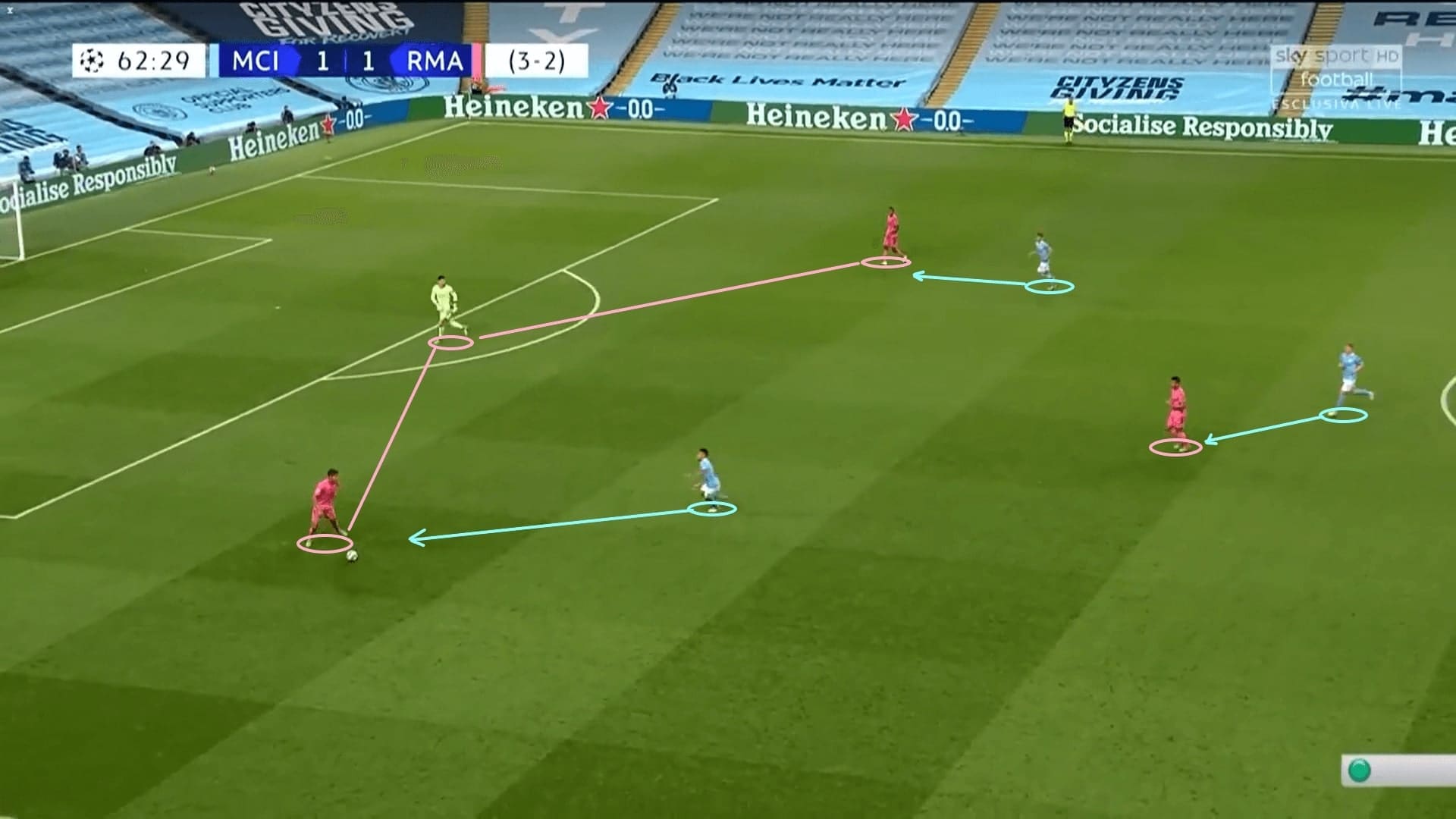
Lastly, we have to show Madrid were simply self-destructing. Too many individual errors were made at the Etihad, and six of the 77 losses have led to a shooting event, including plenty in the box as the losses graph below suggests.
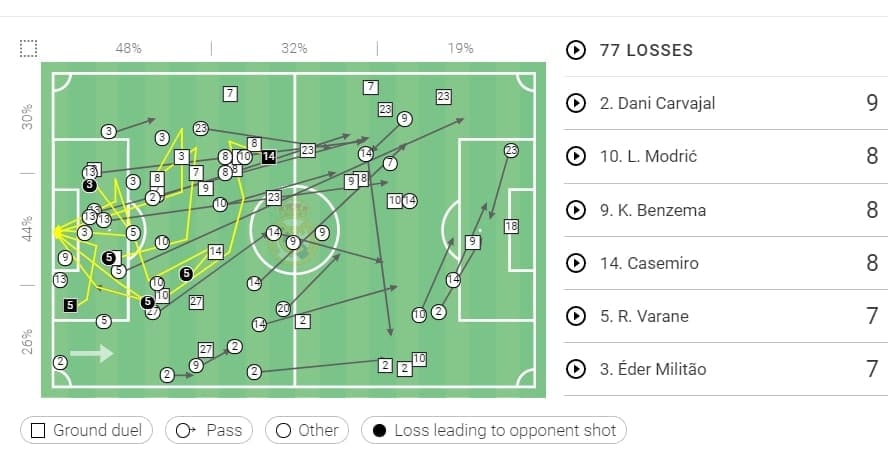
Final remarks
They are there, City are there – this was a high standard performance and let’s not forget a certain level of fortune was involved. Teamwork, individual quality and moments of brilliance are the elements that contributed to the victory. Although plenty of individuals, especially the likes of Rodri and Cancelo, still have to improve in minor details, the team looked very good from a mental perspective. This win was not easy, but still fully deserved.
Obviously, this was not Madrid’s day. It was unfair to point fingers at Varane only and neglecting the issues of the team. The quality of players is there, but the offensive choices are not really as good, at least not as good as they were in the golden years of this team. I think Madrid have already shown the battle spirit to give City a more difficult game than expected, but their issues remain unsolved.

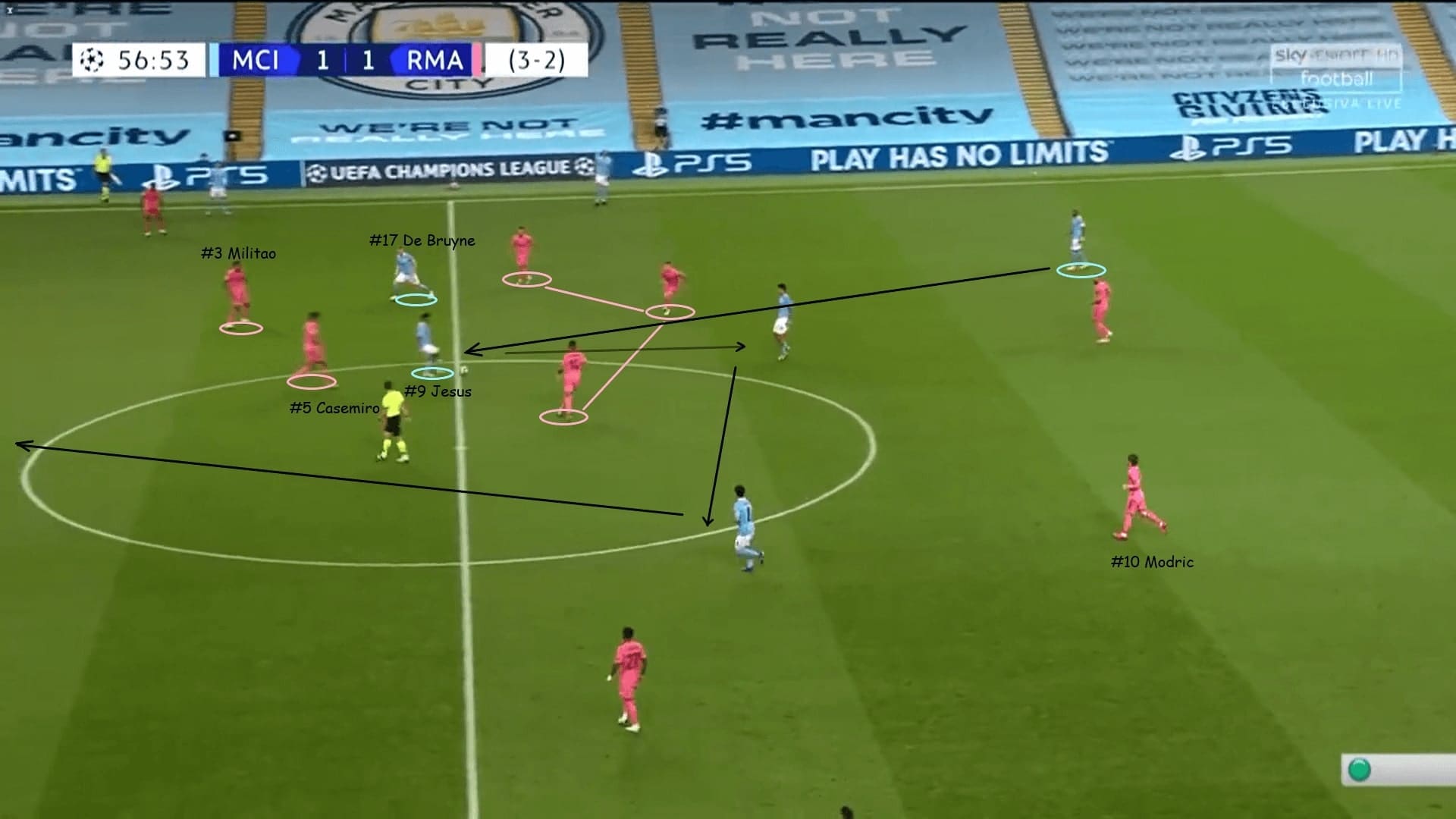


Comments